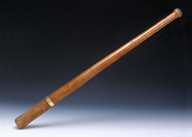In 1867, the Detroit area hosted the World's Base Ball Tournament, and 24 clubs from the United States and Canada took the field to compete in the game that was fast becoming the national pastime. The tradition continues as the Lah-De-Dahs and the Nationals of Greenfield Village play vintage clubs from Michigan, Indiana and Ohio in August of each summer. Watch them duke it out until only one club is left to be declared champion.
Step back in time with us and celebrate the Grand Old Game!
"WORLD'S BASE BALL TOURNAMENT, DETROIT, MICH., 1867."

Actual gold-mounted rosewood trophy bat awarded to the Unknowns for winning first prize in the first class of the 1867 World’s Base Ball Tournament. From the collections of The Henry Ford. |
So read the advertisement for the matches that would offer a first-place prize of $300 in greenbacks to the winner of the first class. The Detroit Base Ball Club sponsored the tournament, and it attracted clubs from the U.S. and Canada. These clubs were entered in one of three classes so that clubs of similar skill might be pitted against each other.
The matches began on the grounds of the Detroit Base Ball Club on August 13, 1867, with the fans paying 25 cents each and 50 cents for each vehicle that entered the property. Seats in the grandstand cost an additional fee. A fence enclosed the ball field. The Detroit Free Press reported extensively on the matches. Crowds as large as 5,000 attended over the tournament's three days.
The Free Press stories also provided insight into the quality of the matches and activities on the field. In a game on the first day, Witherspoon, the second baseman for the Commercial Club of Detroit, was said to have "made kindling of his bat." During the games of the second day, the Free Press described a predecessor to Shoeless Joe Jackson: "Marker of the Unions determined not to be outdone but rather to outdo, and after divesting himself of shoes and stockings ... succeeded in capturing two home runs by low balls." The game accounts also offer an insight into at least some opinions about the introduction of mitts for players. The Free Press writer commented, "We have noticed in all the matches played thus far that the use of gloves by the players was to some degree a customary practice, which we think cannot be too highly condemned and are of the opinion that the Custers would have shown a better score if there had been less buckskin on their hands." The players couldn't be blamed for wanting to protect their hands for defensive purposes; scores such as 41 to 40 and 61 to 32 indicate that offense ruled the diamond.
As for the outcome of the tournament, the championship matches occurred on August 17 and 19 (the 18th, being Sunday, was a day of rest). On Saturday, the match pitted the Allegheny Club of Allegheny City, Pa., against the Unknown Club of Jackson, Michigan. The Free Press claimed the outcome was as much of a surprise to the winning club as it was to the losers. The final score of 29 to 26 earned greenbacks and a gold-mounted rosewood trophy bat for the Unknowns of Jackson. In addition to cash and a prize for finishing second in the group, the Allegheny Club received a set of blue silk flags to serve as foul line markers down the outfield line. The Ann Arbor club won the second class, and a Canadian club, the Victoria of Ingersoll, took the third class.
Rules for the 1867 World's Base Ball Tournament
Base ball in the 1867 Detroit tournament would look only vaguely familiar to us today. The game consisted of nine players and four bases, 90 feet apart, with chalk marking the foul lines. After that, the game began to stray. The pitcher was required to throw underhand, foul balls caught on the first bound put the hitter out and a ball that first bounced fair and rolled foul was a fair ball. Run scoring could be prolific as players seldom wore gloves, and the mitts of the day consisted of a fingerless pad that protected the palm and little else. Foul balls did not count as strikes, and the single umpire warned the hitter before he actually began calling strikes. He likewise warned the pitcher to deliver fair pitches before he called any balls. After such a warning, three balls allowed the runner to take his base, and any combination of three called or swinging strikes was an out. That rule remains today: Three strikes and you're out, and three outs is a turn at the plate. As you watch the game, feel free to ask our players about any rule that confuses you. It's a grand old game, but one that can be confusing to modern visitors.
|
